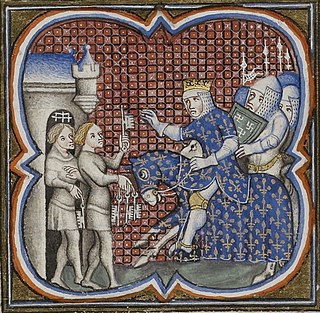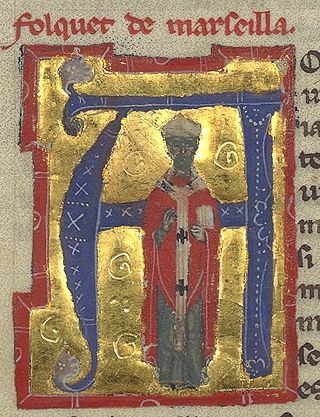Related Research Articles

Bernard of Clairvaux, O. Cist., venerated as Saint Bernard, was an abbot, mystic, co-founder of the Knights Templar, and a major leader in the reformation of the Benedictine Order through the nascent Cistercian Order.
Ecclesia may refer to:

Pope Honorius III, born Cencio Savelli, was head of the Catholic Church and ruler of the Papal States from 18 July 1216 to his death. A canon at the Basilica di Santa Maria Maggiore, he came to hold a number of important administrative positions, including that of Camerlengo. In 1197, he became tutor to the young Frederick II. As pope, he worked to promote the Fifth Crusade, which had been planned under his predecessor, Innocent III. Honorius repeatedly exhorted King Andrew II of Hungary and Emperor Frederick II to fulfill their vows to participate. He also gave approval to the recently formed Dominican and Franciscan religious orders.

Louis VIII, nicknamed The Lion, was King of France from 1223 to 1226. As a prince, he invaded England on 21 May 1216 and was excommunicated by a papal legate on 29 May 1216. On 2 June 1216, Louis was proclaimed "King of England" by rebellious barons in London, though never crowned. He soon seized half the English kingdom but was eventually defeated by the English. After the Treaty of Lambeth, he was paid 10,000 marks, pledged never to invade England again, and was absolved of his excommunication.

The Holy Lance, also known as the Lance of Longinus, the Spear of Destiny, or the Holy Spear, is alleged to be the lance that pierced the side of Jesus as he hung on the cross during his crucifixion. As with other instruments of the Passion, the lance is only briefly mentioned in the Christian Bible, but later became the subject of extrabiblical traditions in the medieval church. Relics purported to be the lance began to appear as early as the 6th century, originally in Jerusalem. By the Late Middle Ages, relics identified as the spearhead of the Holy Lance had been described throughout Europe. Several of these artifacts are still preserved to this day.

Thomas Wright was an English antiquarian and writer. He is chiefly remembered as an editor of medieval texts.
Pérotin was a composer associated with the Notre Dame school of polyphony in Paris and the broader ars antiqua musical style of high medieval music. He is credited with developing the polyphonic practices of his predecessor Léonin, with the introduction of three and four-part harmonies.
Organum is, in general, a plainchant melody with at least one added voice to enhance the harmony, developed in the Middle Ages. Depending on the mode and form of the chant, a supporting bass line may be sung on the same text, the melody may be followed in parallel motion, or a combination of both of these techniques may be employed. As no real independent second voice exists, this is a form of heterophony. In its earliest stages, organum involved two musical voices: a Gregorian chant melody, and the same melody transposed by a consonant interval, usually a perfect fifth or fourth. In these cases the composition often began and ended on a unison, the added voice keeping to the initial tone until the first part has reached a fifth or fourth, from where both voices proceeded in parallel harmony, with the reverse process at the end. Organum was originally improvised; while one singer performed a notated melody, another singer—singing "by ear"—provided the unnotated second melody. Over time, composers began to write added parts that were not just simple transpositions, thus creating true polyphony.

Simon de Montfort, 5th Earl of Leicester, known as Simon IVde Montfort and as Simon de Montfort the Elder, was a French nobleman and knight of the early 13th century. He is widely regarded as one of the great military commanders of the Middle Ages. He took part in the Fourth Crusade and was one of the prominent figures of the Albigensian Crusade. Montfort is mostly noted for his campaigns in the latter, notably for his triumph at Muret. He died at the Siege of Toulouse in 1218. He was Seigneur of Montfort from 1188 to his death and Earl of Leicester in England from 1204. He was also Viscount of Albi, Béziers and Carcassonne from 1213, as well as Count of Toulouse from 1215.
Flodoard of Reims was a Frankish chronicler and priest of the cathedral church of Reims in the West Frankish kingdom during the decades following the dissolution of the Carolingian Empire. His historical writings are major sources for the history of Western Europe, especially France, in the early and mid-tenth century.
Johannes de Garlandia was a French music theorist of the late ars antiqua period of medieval music. He is known for his work on the first treatise to explore the practice of musical notation of rhythm, De Mensurabili Musica.

Folquet de Marselha came from a Genoese merchant family who lived in Marseille. He is known as a troubadour, and then as a fiercely anti-Cathar bishop of Toulouse.
Roland of Cremona was a Dominican theologian and an early scholastic philosopher. He was the first Dominican regent master at Paris, France (1229–1230). He was among the most enthusiastic of those who made use of the newly translated Aristotle in the early 13th century.

Johannes de Garlandia or John of Garland was a medieval grammarian and university teacher. His dates of birth and death are unknown, but he probably lived from about 1190 to about 1270.
Dictionarius is a short work written about the year 1200 by the medieval English grammarian Johannes de Garlandia or John of Garland. For the use of his students at the University of Paris, he lists the trades and tradesmen that they saw around them every day in the streets of Paris, France. The work is written in Latin with interlinear glosses in Old French.
Parisiana poetria is a work by the medieval English grammarian Johannes de Garlandia or John of Garland. Written about 1240, it is a textbook of the writing of Latin prose, classical verse and medieval (rhythmical) verse, aimed at his students at the University of Paris.

Hélie de Talleyrand-Périgord was a French Cardinal, from one of the most aristocratic families in Périgord, south-west France. Hélie was born at Périgueux, third son of Elias VII, Count of Périgord, and Brunissende of Foix, daughter of Roger Bernard III, comte de Foix. His elder brothers were Archambaud (IV), who inherited the County, and Roger-Bernard ; his younger brother was Fortanier, and his sisters were Agnes, Jeanne, Marguerite, and Rosemburge. As a third son Hélie was destined for an ecclesiastical career. His brother, Roger Bernard, too, had an ecclesiastical career, becoming Canon of Lyon. But then, the eldest son died, and Roger-Bernard became the Count of Périgord. Hélie became a major figure in the Avignon papacy, and also a diplomat engaged in the negotiations of the Hundred Years' War, having friendships in both English and French royal families. In his last months he had been appointed Papal Legate for a crusade against the Turks.
William de Blois was a medieval Bishop of Lincoln. He first served in the household of Hugh du Puiset, the Bishop of Durham, then later served the household of Hugh of Avalon, Bishop of Lincoln. After Hugh's death and a two-year vacancy in the see, or bishopric, Blois was elected to succeed Hugh in 1203. Little is known about his episcopate, although 86 of his documents survive from that time period. He died in 1206 and was buried in his cathedral.

The Diocese of Nîmes is a Latin diocese of the Catholic Church in France. The diocese comprises all of the department of Gard. It is a suffragan of the Diocese of Avignon.
De Mensurabili Musica is a musical treatise from the early 13th century and is the first of two treatises traditionally attributed to French music theorist Johannes de Garlandia; the other is de plana musica. De Mensurabili Musica was the first to explain a modal rhythmic system that was already in use at the time: the rhythmic modes. The six rhythmic modes set out by the treatise are all in triple time and are made from combinations of the note values longa (long) and brevis (short) and are given the names trochee, iamb, dactyl, anapest, spondaic and tribrach, although trochee, dactyl and spondaic were much more common. It is evident how influential Garlandia's treatise has been by the number of theorists that have used its ideas. Much of the surviving music of the Notre Dame School from the 13th century is based on the rhythmic modes set out in De Mensurabili Musica.
References
This article includes a list of references, related reading, or external links, but its sources remain unclear because it lacks inline citations .(June 2024) |
- Johannis de Garlandia De triumphis ecclesiae ed. Thomas Wright. London: Nichols, 1856. [Text]
- Two Medieval Satires on the University of Paris: La Bataille des VII Ars of Henri d’Andeli and the Morale Scolarium of John of Garland ed. Louis John Paetow. Berkeley: University of California Press, 1927. [Life of Johannes de Garlandia]